At a thematic seminar on Vietnamese traditional paintings, M.A Nguyen Sinh Phuc, Vice-principal of Yen Bai College of Culture, Art, and Tourism is showing us the pictures taken in the “Cap Sac” ceremony of the Dao ethic people in Yen Bai province. The ritual - an indispensable proceeding in the life of every Dao male, is decorated mysteriously and visionally with many worship paintings hung around the altar, which is placed at the most solemn position of the house. There is a portrait of the Jade Emperor and several gods of Dao people, who are invited to the house to witness the maturity of the man in the family. The presence of those worship paintings within the three days and two nights of many different big and small rituals prove how important they are. Phuc told us: “The custom of using paintings in worshiping and in ritual ceremonies derived from the people’s belief of super-nature’s existence and even the smallest thing has soul. That’s why worship paintings have played an important role in ethnic people’s spiritual practices. As these are not conventional paintings used for decoration purposes, it took several steps so that people could bring those paintings to worship at their own home. There’re two types of worship paintings, one of which has existed for more than 100 years, and is very hard to collect now. The other type, which is now commonly used by local people, is newly-painted by shamans.”
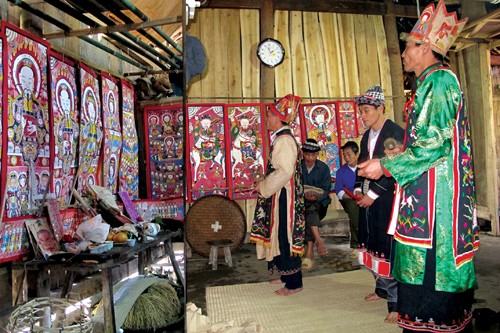 |
| The “Cap Sac” ceremony of the Dao ethic people in Yen Bai province is decorated mysteriously and visionally with many worship paintings hung around the altar, which is placed at the most solemn position of the house (Source: Earlybird. vn) |
As being mainly used in ritual ceremonies, the worship paintings contain spiritual elements. Bui Phan Anh, a student from the Culture and Heritage Department of Hanoi Culture University. “Unlike other kind of folk paintings that I know such as Dong Ho and Hang Trong folk paintings, which are used in daily life as decoration items, the worship paintings of the northern ethnic groups attract me because of their religious value. I admire them simply because I think they not only reflect the ethnic culture but also embrace many spiritual aspects.”
Vu Dong Thanh, a student from the Culture and Heritage Department of Hanoi Culture University, said: “I was impressed by the worship paintings from the very first moment I looked at them. They make me think of an enlightening spirit. Apart from the gods that the Kinh people worship, the ethnic people in the northern regions have their own gods, who are believed to protect and support their lives as the gods of wind, crop and prosperity.”
 |
Being mainly used in ritual ceremonies, the worship paintings contain spiritual elements
(Source: Earlybird.com.vn) |
Worship paintings are not made to be simply hung on the wall for decoration purposes. They are used when there is a funeral or praying session in the village, or in religious practice ceremonies. Using one motif, people from different groups create different versions to match their artistic sense. M.A Le Quoc Huy from Vietnam Fine Arts Museum elaborates.“For one concept, each ethnic group has its different versions involving minor changes in colors using and drawing lines. Apart from well-established images like dragon, phoenix, and tiger, there have many typical symbols in ethnic people’s belief, for example Wind Genie, Rain Genie, Rice and Crop Genie. Anonymous artisans created those motifs to praise their ancestors and gods for educating people to live a better life, or sometimes they just simply paint people’s dreams of the other worlds after they die.”
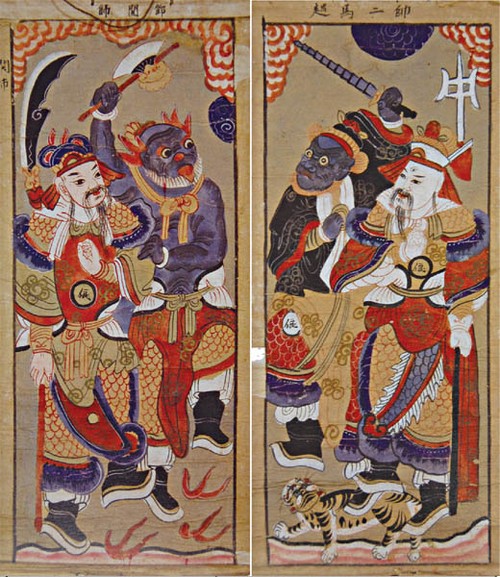 |
Worship paintings are not made to be simply hung on the wall for decoration purposes
(Source: Earlybird.com.vn ) |
Ethnic minority worship paintings were usually drawn by anonymous artists or shamans, whose works often contain not one, but many layers of meaning. Beside patience and skill, the worship paintings require strict obedience of rules. Mr. Phuc explains: “The Sharman draw worship paintings on papers made from trees in the forest, and colors taken from soil, seashell, tree bark, and so on, which gave the paintings a mysterious feeling when looking at. The Sharman’s painting room is a separate place arranged with strict spiritual principles. He had to keep his mind and body pure during his work.”
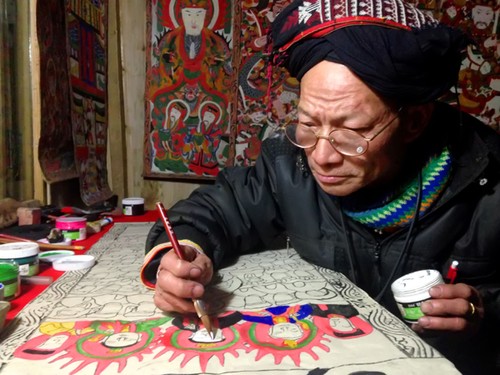 |
| Ethnic minority worship paintings were usually drawn by anonymous artists or shamans, whose works often contain not one, but many layers of meaning (Source: Baolaocai.vn) |
Before entering the painting room, the Sharman has to keep himself clear of negative thoughts, fear, and worry. He would follow a vegetarian diet for days and be isolated from women, so that he could devote his entire creativity to the worship paintings. By doing so, the ethnic people believe that the worship painting would be drawn with a reverent attitude. In a worship painting, the gods and the deities are always larger and placed in the upper positions or in the center of the paintings while the ordinary people are smaller in size. The good and bad people can easily be recognized just by their appearance. Those unique characteristics make the paintings profoundly impressive. M.A Le Quoc Huy again: “It requires specific skills to paint emotions and sacredness into a worship painting. Under the feather brush of the mountainous shaman, the good and bad are depicted in the form of lively characters. The good people often have white faces and long beards while the bad ones have black faces and bug eyes. The worship paintings contain educational meaning, in which good people are always cherished while bad ones always suffer karmas.”
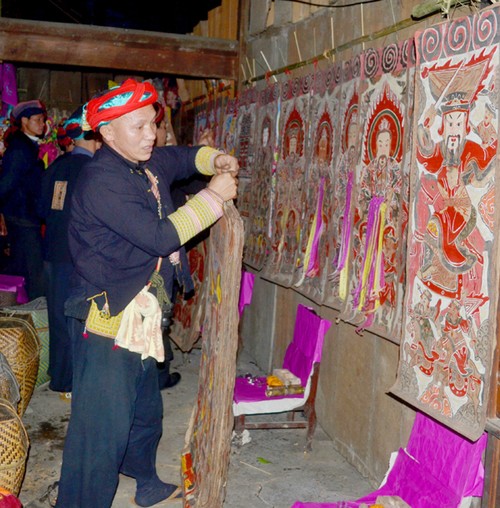 |
| Ethnic people believe that family members should be sincere in worship ritual to be blessed with health and wealth (Source: Baolaocai.vn) |
Ethnic people believe that family members should be sincere in worship ritual to be blessed with health and wealth. Thus, the ritual ceremonies which involve those worship paintings take so much time for preparation. Mr Sinh Phuc tells his story when collecting the documents about those worship paintings. “Families who wished to have a set of worship paintings would choose good days to take many strict steps to ask for Gods’ permission to bring those paintings home. As the paintings are believed to be holy and to have a special connection with ethnic people’s ancestors and gods, it’s very hard for the researchers like us to access them. We have to come to the shaman’s home or visit the ritual ceremonies, for example “Cap sac” ceremonies, funeral, and burial rituals, to collect the documents. Each visit took us even months with many complicated religious practice ceremonies to take pictures of those paintings.”
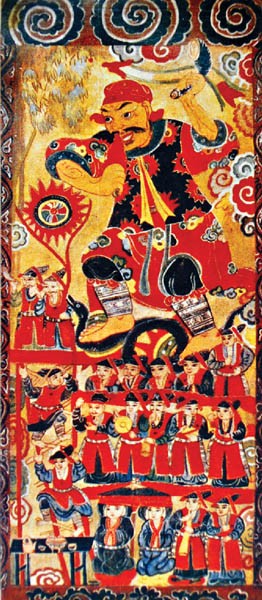 |
In a worship painting, the gods and the deities are always larger and placed in the upper positions or in the center of the paintings while the ordinary people are smaller in size
(Source: tdcn.hou.edu ) |
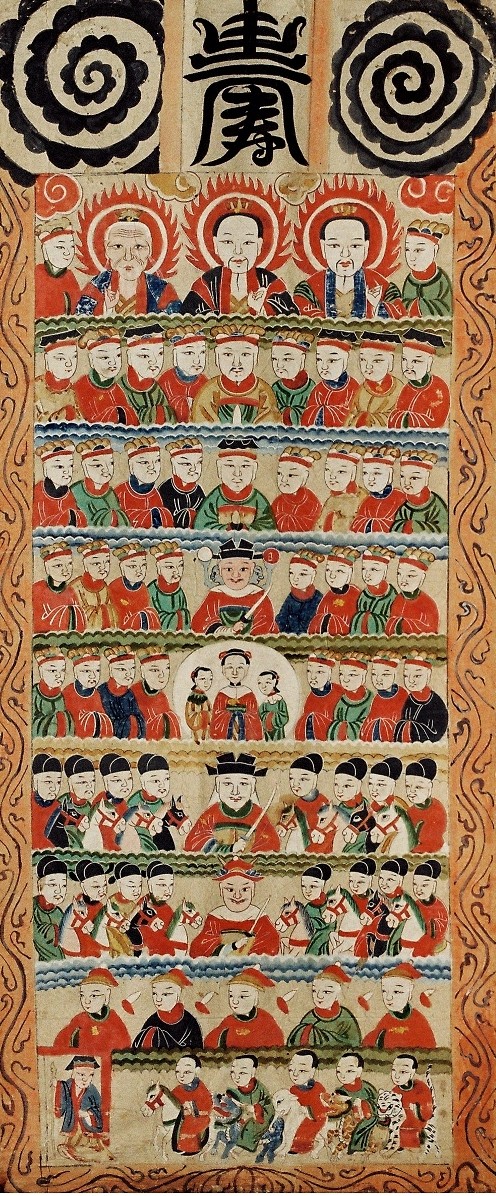 |
Families who wished to have a set of worship paintings would choose good days to take many strict steps to ask for Gods’ permission to bring those paintings home
(Source: Earlybird.com.vn) |
The worship paintings capture the essence of Vietnam’s northern ethnic groups. However, parts of the sophisticated works are lost when production is somehow discontinued because of the rapid growth of modern society. Some techniques are not handed down to the next generation as the youth now pay less attention to this kind of traditional art. MA Nguyen Sinh Phuc said he is concerned about the fading fine-art.“The worship paintings are now all made by a few shaman living scattered throughout the northern regions. At the age of over 80, those shamans are now struggling to find successors to take over the work. There remains a question that need to be answered now. How can we preserve and develop those worship paintings when the painters are all getting older and the youth pay less attention to the paintings?”
This week, we’ve been talking about the worship paintings of the Vietnam’s northern ethnic groups. We welcome your feedback at: English section, VOVworld, Radio Voice of Vietnam, 45 Ba Trieu Street, Hanoi, Vietnam. Or you can email us at: englishsection@vov.org.vn. Tune in to our English program on the Internet at vovworld.vn. Good bye. See you next time.